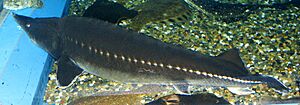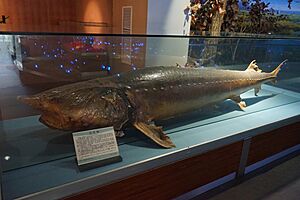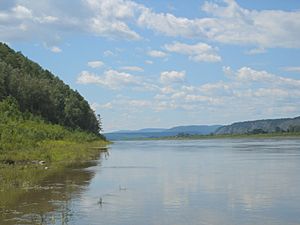Kaluga (fish) facts for kids
Quick facts for kids Kaluga (fish) |
|
|---|---|
 |
|
| A kaluga in an Asamushi Aquarium | |
| Conservation status | |
| Scientific classification | |
| Genus: |
Huso
|
| Species: |
dauricus
|
| Synonyms | |
|
|
The kaluga (Huso dauricus), also called the river beluga, is a giant sturgeon fish. It lives in the Amur River basin, a large river between China and Russia. Kalugas are among the biggest sturgeons, growing up to 5.6 meters (18.6 feet) long and weighing over 1,000 kg (2,205 lb).
Like the slightly larger beluga sturgeon, the kaluga spends some of its life in salty ocean water. But it mostly lives in fresh water. This fish has five main rows of bony plates called scutes. Kalugas eat salmon and other fish in the Amur River. They have gray-green to black backs and a yellowish-green-white belly.
People have hunted the kaluga almost to extinction for its valuable eggs, called roe or caviar. Even with patrols trying to stop it, illegal fishing still happens. In Russia, catching kaluga illegally in the Amur River is a serious crime. Kalugas are known to be very strong. There have been reports of them causing trouble for fishing boats.
Description
The kaluga sturgeon is a huge fish. It has a triangle-shaped head with several bony plates. Its body is long and shaped like a torpedo. It has five rows of bony scutes. These include 10-16 scutes on its back, 32-46 on each side, and 8-12 on its belly.
The kaluga's mouth is very large and crescent-shaped. It takes up the whole bottom of its snout. Parts of its mouth can even move to the side of its head. Under its snout, in front of its mouth, are four flat, whisker-like feelers called barbels. The two inner barbels are a bit further forward than the outer ones.
The kaluga sturgeon has a short, pointed snout. Its eyes are very small and are located right behind its nostrils.
Habitat
Kaluga sturgeon are semi-anadromous. This means they spend some time in salty ocean water but most of their lives in fresh water. Kalugas are one of four types of sturgeons that live in the Amur River. The Amur River is one of the biggest rivers in East Asia. It forms part of the border between China and Russia.
Two groups of Kaluga live in this river. One group lays its eggs in the main part of the river. The other group lays eggs downstream and then moves towards the middle of the river. When they are very young, kaluga babies like clear water. They prefer parts of the river with a bright, open bottom. They swim high above the riverbed.
Young kalugas also try to avoid any hiding spots in the river. Scientists think this might be to stay safe from predators that live near the bottom. Kaluga sturgeon are now endangered because of human actions. However, warm water can also cause fungus on young embryos, which can lead to death.
How much the kaluga migrates is also important. Stronger water currents make it more likely for young embryos to drift. This drifting is called passive migration because the babies cannot control where the river takes them. But adult kalugas actively swim back and forth between upstream and downstream areas. Kalugas can live for at least 20 years, similar to humans.
Life cycle
Kaluga sturgeon hatch in shallow, gravelly areas in the freshwater parts of the Amur River. Their parents do not care for them. They stay in their eggs for 83 to 295 hours. When they hatch, they have a yolk sac that feeds them for about 8 or 9 days. After that, young kalugas must find their own food.
They hunt for tiny zooplankton, insects, and shrimp. The river current helps them reach the sea. They stay in the sea until they are ready to breed, which is between 10 and 14 years old.
Kalugas return to rivers to breed. They lay eggs in the lower parts of the Amur River. They choose areas with strong currents and gravel or sandy-gravel bottoms. The water temperature is usually 12-20 °C (70 °F), and the depth is 2–3 meters (6–10 feet).
Egg-laying is busiest from late May to July. Adult kalugas lay eggs many times during their lives. Females lay eggs every 4–5 years, and males every 3–4 years. Water temperature affects when females become ready to breed. Females may lay eggs a year earlier in warm years than in cold years.
Adult kaluga sturgeons travel in small groups of 3 to 20 to the shallow gravel beds to lay eggs. Sometimes, if a kaluga is too big, it might get stuck in the shallow water and die. Kaluga sturgeon can also breed with the Amur sturgeon, creating mixed offspring.
Diet
Adult Kaluga sturgeon have very big appetites. They eat many different fish and shellfish. This includes pike, carp, herring, chum salmon, and keta. They will eat almost any fish or shellfish that can fit into their large mouths. A Kaluga sturgeon can live for up to 55 years.
Conservation
The number of kaluga sturgeon is decreasing for several reasons. One main reason is too much fishing. Since the 1900s, people have caught them illegally at a very high rate. For example, in 1948, after World War II, 61 metric tons of Kaluga were caught. This was a huge number for such a large fish.
Kalugas are very vulnerable to illegal fishing because they mature late. They can only start breeding when they are between 6 and 25 years old. The eggs (caviar) from sturgeon, including kaluga, are considered a special food around the world. From 1957 to 2005, about 117 tons of sturgeon caviar were produced each year. This demand for caviar reduces the kaluga population and speeds up their decline.
Another reason for their endangerment is river pollution. This is especially true near the areas where they lay eggs. Pollution can harm the eggs and cause problems for the baby fish. Also, mixed-breed fish between Japanese sturgeon (Acipenser schrenckii) and kaluga (Huso dauricus) have appeared in the wild. These hybrids can pose a threat to the pure kaluga species.
Population Trends
Information about kaluga sturgeon numbers comes from different ways of tracking catches. The species has seen a big drop in how many are caught since the late 1800s. For example, China saw an 80% drop in adult fish between 2008 and 2018. In the late 19th century, about 500 tons were caught each year. But by 1992, this had fallen to only 92 tons.
In 2012, the number of fish in the lower river was estimated at 7,100 tons. No legal fishing targets this species anymore. However, it faces serious threats from illegal fishing, especially in Russia. All these factors together have led to a drop of over 90% in just 90 years. This is about three generations of the species.
Protection
The Convention on International Trade in Endangered Species of Wild Fauna and Flora (CITES) is an international agreement. It was signed by 180 countries. Its goal is to make sure that trading animals and plants across borders does not threaten their survival. The treaty was created in Washington, D.C., in 1973 and started in 1975.
The kaluga is protected by Appendix II of CITES. This list includes species that are not currently endangered but could become so without trade rules. Regulated trade is allowed if the exporting country gives a permit. This permit is given only if the fish were caught legally. Also, the trade must not harm the species or its role in the environment.
In addition, countries have passed their own laws to protect the kaluga sturgeon. Commercial sturgeon fishing was banned in the Soviet Union during certain periods: 1923-1930, 1958-1976, and from 1984 until now. The kaluga sturgeon was added to Appendix II of CITES in 1998.





